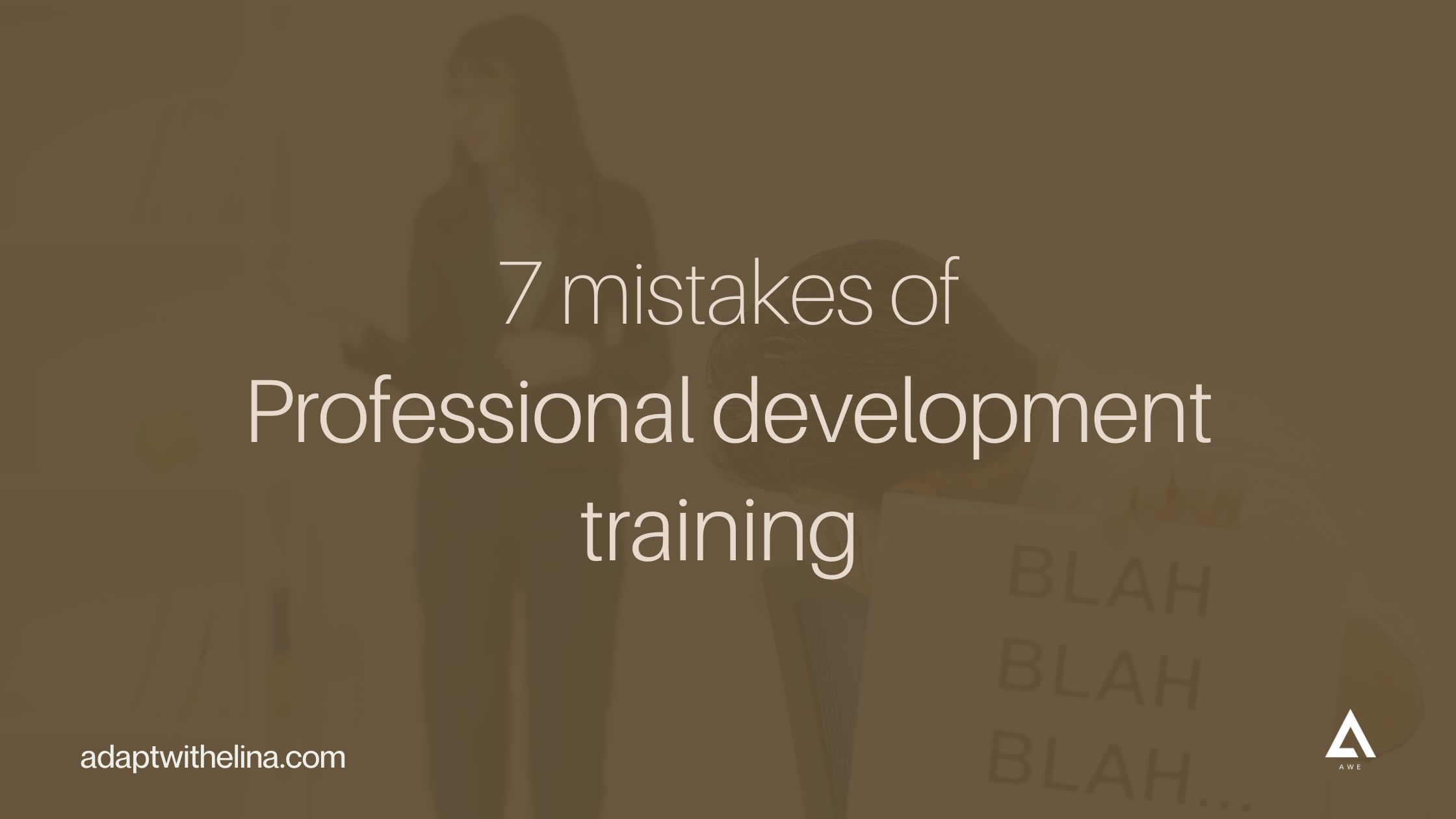Professional development training for your team is a necessity during times when any industry experiences change at the speed of light.
However, the path to successful training isn’t always straightforward, isn’t it? In this blog, we’ll explore 7 common mistakes and, more importantly, how to avoid them.
Whether you manage training for your company or want to improve your career, these tips will help you avoid mistakes and achieve valuable growth in a shorter time.
Or – ensure that the investment you make in professional development pays dividends for both individuals and organizations.
Now, without further ado, let’s dive into mistake number 1.
1. Not Choosing Practical Skills Training
A common mistake made by managers when hiring professional development training is choosing workshops or programs that promise a new and unheard approach, rather than focusing on practical skills training.
It’s like choosing a new and intriguing diet over a long-lasting and healthy lifestyle that is “boring” because “we’ve already heard about it before”.
Why It’s a Mistake:
– Entertainment vs. Learning: Opting for a new and sparkly workshop can sometimes be driven by a desire for entertainment rather than genuine learning and skill development.
– Wrong Focus: Now, don’t get me wrong, innovative approaches can be valuable! However, the primary goal of professional development should be to train employees in skills that they can use in their day-to-day work.
– Lack of Application: If the innovative concepts or approaches in the professional development training are new but lack practical implementation, you’re spending money with no ROI. If there’s nothing your team can use immediately, the training may not result in tangible improvements.
How to Avoid this Mistake:
– Identify Specific Skills: Identify the specific areas where employees need improvement. Focus on practical skills that will directly enhance their job performance and contribute to organizational goals.
– Prioritize Practical Over New: When evaluating different training options, prioritize practical, hands-on learning experiences. Look for workshops or programs that include real-world scenarios, role-playing, and skill-building exercises.
– Evaluate Impact: After the training, assess its impact on employee performance. Are employees applying the skills they learned in their day-to-day activities? We’ll talk more about this point later – because how you do it could also be a common mistake.
Remember that while innovative approaches have their time and place to shine, the main goal of professional development training is to empower employees with practical skills that enhance their ability to excel in their roles.
So – practical over new.
2. Relying Too Heavily on One-Time Workshops

A big mistake HR and managers make is thinking that one-time professional development workshops or sessions are enough for employee growth.
Sometimes it just seems easier to plan a full-day workshop than do the same training over 4-6 weeks. However, that is a mistake, and let me tell you why.
Why It’s a Mistake:
– Limited Impact: One-time workshops may provide a short-term boost in knowledge or skills, but the impact soon diminishes. Employees may struggle to apply what they’ve learned without repeating it again and again in a training environment.
– Inefficient Use of Resources: Investing heavily in sporadic workshops without a long-term learning strategy can lead to inefficient use of resources, both in terms of time and budget.
In simple terms, it’s like wanting your employee to learn how to read, and then asking a professor to show the alphabet once. Or even worse – talk about it charismatically for 4 hours. And then you’d expect everyone to read.
We as humans are designed in a way that we need to repeat the same thing over and over again to make it stick. New habits form on average within 60 days, but depending on the difficulty level of the habit, even more.
Now, here’s what to do to not make this mistake.
How to Avoid It:
– Choose longer-term training. Or think of the one-day workshop as an intro to the topic, to kickstart the new skills. And then plan 5-10 continuous, but shorter weekly training sessions to carve the new skills into your team’s behaviour.
For example, my programs are 8 weeks with 2-4 weeks of a break in the middle.
– Use one workshop as a ‘taster’, if you will, to see if the facilitator is the right fit, or if this training method and style is the right fit for your team. This also can be a way to spend your company’s resources more effectively.
– Offer a Variety of Resources: Provide a mix of learning resources, including workshops, online courses, mentorship programs, and access to relevant literature or materials. This diversity allows employees to choose the most suitable options for their needs. And that makes them stick to the longer training programs.
So the best approach, if you want to change your team, and not check off a wellness activity in your work tasks, is to use the one seminar to test how well the speaker connects to your team, and then continue working with them at least for 6-10 weeks to see the results.
Whether we want it or not, repetition is the mother of the knowledge, and I’d even add to this saying. I’d say the repetition is the mother of embodying knowledge.
3. Making the training mandatory
Another mistake that HR professionals and managers commonly make when implementing professional development training is insisting that every employee attend the training, making it mandatory for all.
Why It’s a Mistake:
– Forced Participation: Mandating attendance can lead to reluctant participants who may not be genuinely interested in the training topic. This can result in disengagement and a lack of enthusiasm during the sessions. Even from those who are genuinely interested.
– Variable Outcomes: People who are pushed to training, tend to challenge the topic or the trainer, by starting long discussions. While it’s good to discuss the topic, this type of discussion is unproductive most of the time, as the unmotivated employee is like the kid who asks the teacher about their holidays to postpone the calculus.
That makes the learning process slower and takes the focus off the skills training itself. Therefore the results will be worse than they could be.
– Wasted Resources: Resources, including time and budget, may be wasted on employees who do not fully engage with the training. This can be inefficient and costly for the organization.
There’s a saying – if a person doesn’t want to do something, nothing will stop them. So respect that and try these strategies for better results in your next professional development training.
How to Avoid It:
– Initial Mandatory Session: Consider starting with a mandatory introductory session or seminar that introduces the training topic to all employees. That gives a chance for those who are sceptical to test the topic, the trainer’s style and authority – and sometimes even become less sceptical. This ensures that everyone is aware of the subject matter and its potential benefits.
– Voluntary Participation: After the introductory session, transition to a voluntary participation model. Allow employees to choose whether they want to attend the full weekly training or workshops.
– Showcase Results: Let the results speak for themselves. Share success stories and outcomes from those who voluntarily participated in the training. When employees see the positive impact on their colleagues, they may be more inclined to join voluntarily.
– Progressive Training Rounds: Consider offering training in rounds. Start with those who volunteer, and once their results are evident, open another round for those who want to experience similar benefits. This approach allows the results to snowball organically.
If the program is still lacking in results, or there are not enough volunteers to continue the long-term training, you’ve spent your company’s money as effectively as possible. A win-win. And this is the time when you can try innovative approaches because the previous ones didn’t work.
Sometimes the resistance underlines a more important issue, like the workload of employees and their ability to manage it with extra training. So this has to be resolved before you hire the next facilitator.
Overall – let the results of the training speak for themselves to the volunteers, and then the results will snowball.
4. Overloading Training Content

Another mistake often made by HR professionals and managers when hiring professional development training is overwhelming employees with an excessive amount of content in a single session or program.
Why It’s a Mistake:
– Cognitive Overload: Too much information presented too quickly can overwhelm participants, making it challenging for them to absorb and retain key concepts. This means they will remember less and the training will be less effective.
– Limited Application: When training content is overloaded, employees may struggle to apply what they’ve learned in their day-to-day roles, defeating the purpose of your professional development training.
– Loss of Engagement: Participants may disengage or lose interest when faced with information overload, reducing the overall effectiveness of the training program.
Now, most of us know that feeling when we have too much to do that we ignore all of it and start cleaning the fridge. Only this time the fridge is the daily tasks of the employee, and the important task, that never sees the sunlight, is the new skill.
How to Avoid It:
– Chunk Information: Divide the training content into manageable chunks or modules. Or make sure one training session covers one topic only. Also, check if employees can practice what they learned in microsteps in their everyday lives between sessions. This allows participants to absorb and apply each component before moving on to the next.
– Prioritize Key Concepts: Focus on the most crucial skills and knowledge that participants need to acquire. Avoid unnecessary details or topics that are not directly relevant to their roles.
– Active Learning: Incorporate interactive elements such as group discussions, self-reflection exercises, hands-on exercises, and practical applications. These activities make sure that the topic stays in the employees’ minds.
Of course, if you’re hiring a facilitator or skills trainer to create the training programs, simply make sure they tick these boxes to make the training more effective.
Trust me, slower is faster here.
The easy learning process will motivate your employees to continue it for 6-10 weeks. Because let me guess – their schedules are already packed.
5. Neglecting Soft Skills Development
Another common mistake made by HR professionals and managers when hiring professional development training is focusing solely on technical or hard skills. Any soft skills training gets neglected.
Why It’s a Mistake:
– Incomplete Skillset: Employees require a balance of technical and soft skills to excel in their roles. Neglecting soft skills like communication, teamwork, and adaptability can hinder overall performance in the long term. Because the soft skills are underlying the hard skills, it makes it harder to implement their knowledge and tackle new challenges if the team’s skills rely solely on technical knowledge.
– Interpersonal Challenges: in most projects, poor communication and lack of other soft skills are the main reasons why projects fail or miss deadlines. Lack of soft skills can lead to communication breakdowns, conflicts, and difficulties in collaborating effectively with colleagues, clients, or customers.
– Leadership Deficits: For managers, soft skills like leadership, emotional intelligence and adaptability intelligence are critical for leading and motivating teams. Neglecting these skills can result in poor team dynamics and low morale.
How to Avoid It:
– Identify Relevant Soft Skills: Assess the specific soft skills needed for success in your organization. This may vary by department or role. Common soft skills include communication, problem-solving, adaptability, and interpersonal skills. Check this video to learn more about adaptability skills in business.
– Incorporate Soft Skills Training: Include soft skills development as an integral part of your professional development programs. Offer workshops or courses that focus on improving these skills.
– Customize Training: Tailor soft skills training to address the unique needs and challenges of your organization. Provide real-world scenarios and practical exercises to reinforce learning and show why and how these skills matter in work and business.
– Leadership Development: Invest in leadership development programs. Effective leadership often depends more on soft skills than technical expertise, and people always look up to their managers, even unconsciously. If they’re a role model who works on their soft skills, theteam will follow. And everybody will be the winner in this case.
Recognize that soft skills are not just a nice-to-have but a critical component of employee success and overall organizational effectiveness. It shouldn’t even be a discussion nowadays.
Integrating soft skills development into your training initiatives can lead to more well-rounded and adaptable employees.
6. Neglecting the Use of Evaluation Tools

One prevalent mistake HR professionals and managers make when implementing professional development training is neglecting the use of evaluation tools to understand their employees’ actual needs accurately.
It’s a common assumption that we know precisely what skills and knowledge our team members require, but this assumption can often lead to a mismatch between perceived and actual needs.
Why It’s a Mistake:
– Misguided Investments: Without accurate evaluation, organizations may invest in training programs that don’t align with the genuine skill gaps and developmental needs of their employees. This can result in inefficient use of resources and a lack of meaningful progress.
– Skills Gap Identification: The right evaluation tools, such as the Adaptability Intelligence (AQ) assessment, if you want to improve a team’s adaptability skills, provide a clear and data-driven view of the skills employees need to thrive in a fast-changing world. Neglecting such tools, no matter what your topic is, can hinder the identification of critical skill gaps.
– Optimizing Existing Skills: Evaluation tools not only highlight areas for improvement but also reveal the underutilized skills within the team. Ignoring these tools means missing out on opportunities to harness and optimize existing talents.
How to Avoid It:
– Explore Assessment Tools: Research and explore various assessment tools tailored to your organization’s goals. For example, the AQ assessment is one such tool that can precisely identify adaptability needs.
– Credibility check: Choose assessment tools that are based on science – this will be the easiest way to guarantee success.
– Continuous Assessment: Integrate assessment tools as part of an ongoing process rather than a one-time event. Regularly reassess the evolving needs of your team to ensure that training programs remain relevant.
– Holistic Approach: Remember that assessment tools are a piece of the puzzle. Combine them with feedback mechanisms, employee input, and other methods to make sure that you define the real problem as accurately as possible.
I cannot tell you how many times the managers think the problem is “x”, and when we start training sessions, it turns out that the real problem is “a345”. That’s one of the reasons I became an AQ practitioner – to save my client’s time and money. But let’s talk about my story some other time.
By avoiding the mistake of neglecting evaluation tools, you can ensure that your training initiatives are precisely tailored to address your team’s actual needs, fostering adaptability and success in the ever-changing landscape of the modern workplace.
Now, it’s time for the last mistake.
7. Evaluating the Likability of the Training Rather Than Effectiveness

One mistake in training is caring more about whether people liked it than if it helped them. Sometimes, we pay too much attention to how much employees enjoyed the training or how happy they felt during and after it.
Why It’s a Mistake:
– Feelings vs. Actions: Evaluating training primarily based on participants’ feelings can be misleading. While positive emotions are important for engagement and openness to new information, they don’t necessarily indicate that employees have learned practical skills or will apply them.
– Lack of Tangible Outcomes: Overemphasizing likability can lead to overlooking the real impact of the training on employees’ behavior and job performance. Training should result in observable changes in actions and outcomes. And true, real change requires moments of unease. It’s just how the brain works.
– Resource Misallocation: If likability becomes the primary measure of training success, more resources may be spent towards creating entertaining sessions rather than ensuring that your employees acquire the new skills.
How to Avoid It:
– Focus on Behavioral Outcomes: Shift the focus from the team’s feelings about the session to their actions and behavioral outcomes after the training program. Measure the extent to which employees apply the newly acquired skills in their day-to-day work after the whole program is over.
– Define Clear Objectives: Establish specific learning objectives and expected changes in behavior or job performance before implementing training. Use these as benchmarks for evaluation.
– Collect Post-Training Data: Gather data on how employees are applying what they’ve learned in their roles. This may include performance metrics, feedback from colleagues, or direct observations.
Use evaluation tools once more after the training to evaluate whether the problem is solved.
To avoid this mistake, concentrate on evaluating whether the training helps employees acquire real skills and perform better at work. This aligns with the ultimate goal of improving job performance and contributions to the organization.
Professional development training: time to take action!
Professional development is a dynamic and transformative process that can lead to individual and organizational success. If done right.
By recognizing and avoiding these common mistakes, your training initiatives will be more effective, efficient, and aligned with your and your company’s goals.
Now that you’re equipped with valuable insights into avoiding training mistakes, it’s time to take action:
1. Assess Your Training Programs: Review your existing training initiatives and identify any areas where adjustments can be made to align with the principles discussed in this blog.
2. Prioritize Continuous Learning: Encourage a culture of continuous learning within your organization. Support employees in seeking ongoing development opportunities and resources, and sharing opportunities for growth in team or company openly.
3. Customize Training: Tailor training content to meet the specific needs and challenges of your organization. Ensure that the training you provide is relevant and practical and that you’re training the right skills. Make sure you have the tools to measure the results.
4. Embrace Soft Skills: Recognize the importance of soft skills and integrate soft skills development into your training programs.
5. Promote Voluntary Participation: Consider shifting to a voluntary participation model for training. Let employees make choices based on their interests and career goals.
By applying these principles and taking proactive steps, you can transform your professional development training into a powerful tool for growth, both for your team members and your organization as a whole. Not just an activity that is required for a company like yours.
Want to know more about adaptability skills evaluation and training? Contact me for more.

Comments are closed